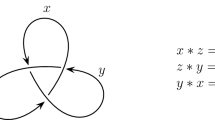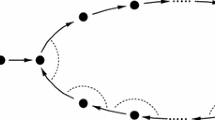Summary
In this paper the notions of “L form” and its “interpretations” are introduced to define families of structurally similar L systems. The families of L systems thus defined are studied from a number of different points of view. It is felt that this novel approach will shed new light on many questions concerning L systems.
Similar content being viewed by others
References
Bertsch, E.: An observation on relative parsing time. J. ACM 22, 493–498 (1975)
Cremers, A. B., Ginsburg, S.: Context-free grammar forms. J. Computer and System Sciences 11, 86–117 (1975)
Ellis, C. : Personal communication
Ginsburg, S.: Algebraic theory of automata. Amsterdam: North-Holland 1975
Ginsburg, S.: A survey of context-free grammar forms. Proc. Conf. on Languages and Automata, Madrid, 1975. Amsterdam: North-Holland 1976
Ginsburg, S., Maurer, H. A.: On strongly equivalent context-free grammar forms. Computing 16, 281–290 (1976)
Ginsburg, S., Mayer, O.: On strict interpretations of grammar forms. Lecture Notes in Computer Science, Vol. 45. Berlin-Heidelberg-New York: Springer 1976
Herman, G., Rozenberg, G.: Developmental systems and languages. Amsterdam: North-Holland 1974
Lindenmayer, A.: Mathematical models for cellular interactions in development. J. Theoretical Biology 18, 280–315 (1968)
Maurer, H. A., Wood, D.: On grammar forms with terminal context. Acta Informatica 6, 397–402 (1976)
Maurer, H. A., Salomaa, A., Wood, D. : Uniform interpretations of L forms. Institut f. Angew. Informatik und formale Beschreibungsverfahren, Universität Karlsruhe, Report 44 (1976)
Nivat, M.: Extensions et restrictions de grammaires algebriques. Proc. Conf. on Languages and Automata, Madrid, 1975. Amsterdam: North-Holland 1976
Nurmi, H.: Some lessons from the study of biological systems for the modeling of social systems. Progress in Cybernetics and Systems Research 1, 237–266 (1975)
Paz, A., Salomaa, A.: Integral sequential word functions and growth equivalence of Lindenmayer systems. Information and Control 23, 313–343 (1973)
Rozenberg, G., Doucet, P.: On OL-languages. Information and Control 19, 302–318 (1971)
Rozenberg, G., Salomaa, A. (eds.): L-systems. Lecture Notes in Computer Science, Vol. 15, Berlin-Heidelberg-New York: Springer 1974
Salomaa, A.: Formal languages. New York-London: Academic Press 1973
Walter, H.: Grammar forms and grammar homomorphisms. Acta Informatica 7, 75–94 (1976)
Author information
Authors and Affiliations
Rights and permissions
About this article
Cite this article
Maurer, H.A., Salomaa, A. & Wood, D. EOL forms. Acta Informatica 8, 75–96 (1977). https://doi.org/10.1007/BF00276185
Received:
Issue Date:
DOI: https://doi.org/10.1007/BF00276185




